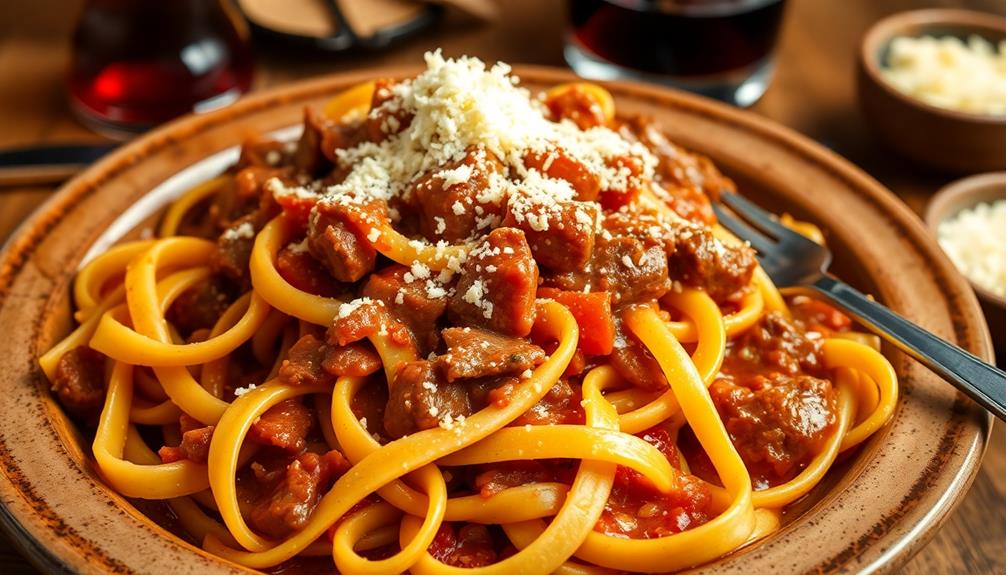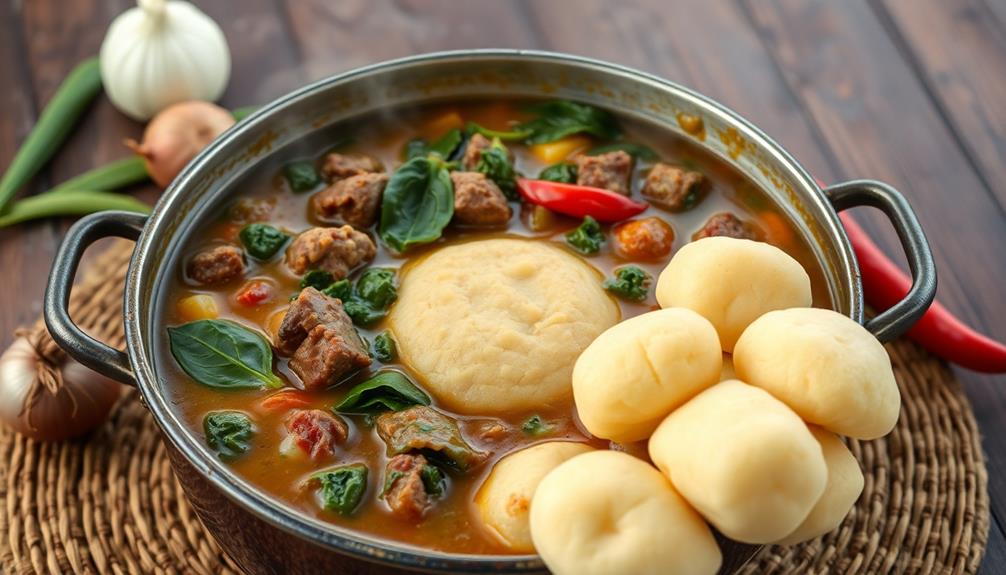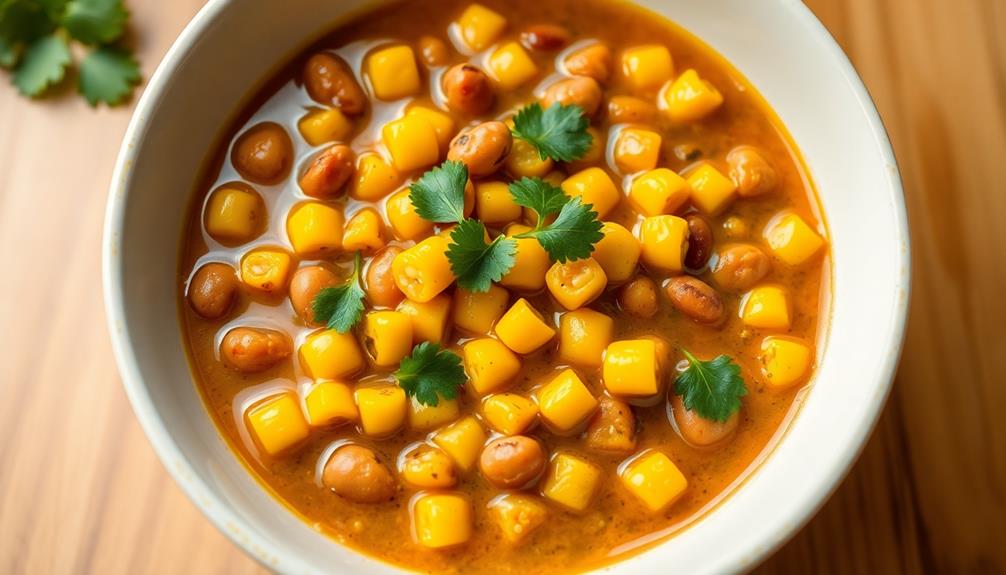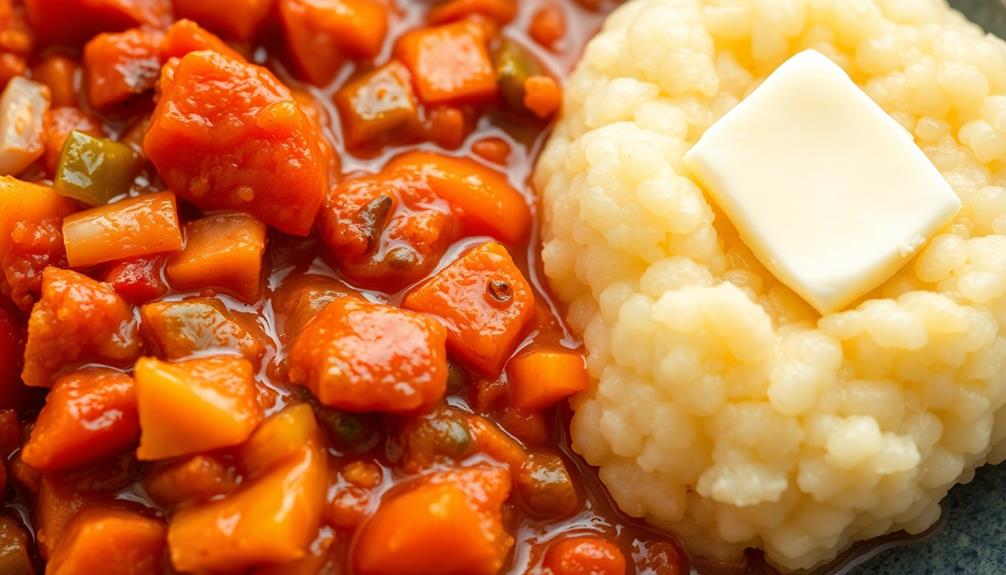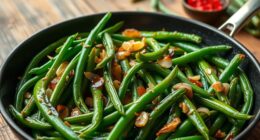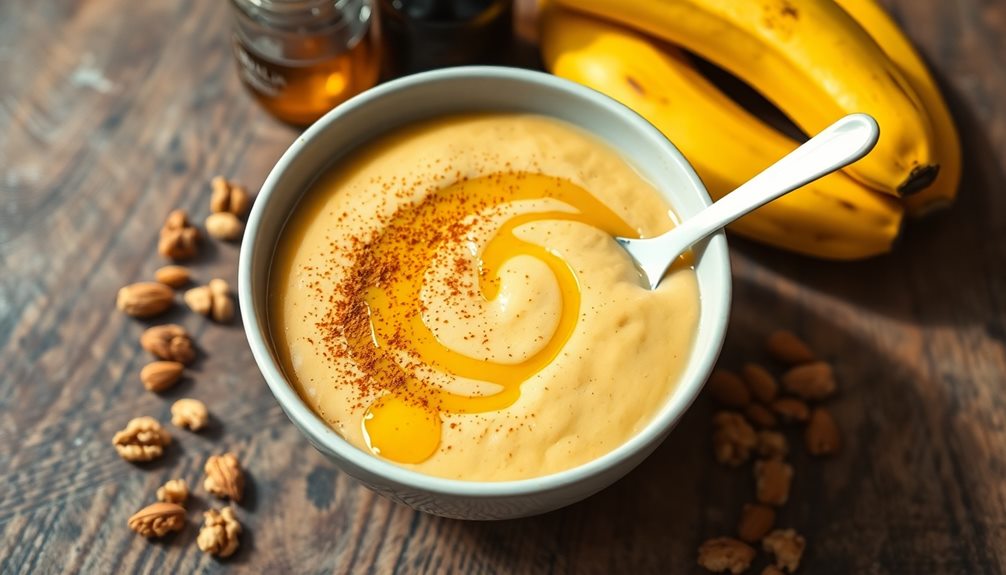Cachupa is Cape Verde's beloved national dish! You'll love this hearty stew that combines corn, beans, and various meats. It's slow-cooked to perfection, allowing all the flavors to blend beautifully. Originally a humble meal, cachupa has become a symbol of Cape Verdean pride and identity. Each island adds its own twist, making it a diverse and exciting dish. You can enjoy it for dinner or try the breakfast version with fried eggs on top. The rich aroma will transport you to the sunny archipelago, and you'll taste the history and culture in every spoonful. Discover the secrets behind this mouthwatering tradition!
History
Although the exact origins of cachupa are unclear, this hearty stew has been a staple of Cape Verdean cuisine for centuries.
You'll find that cachupa's history is deeply intertwined with the islands' colonial past and diverse cultural influences. As you explore the story behind this beloved dish, you'll discover that it's a delicious blend of Portuguese, African, and local traditions.
Back in the day, cachupa was considered a poor man's meal, made from whatever ingredients were available.
You'd see families gathering around big pots of this comforting stew, sharing stories and laughter. Over time, it's become a source of national pride and a symbol of Cape Verdean identity.
The recipe has evolved, too! What started as a simple corn and bean dish has grown to include a variety of meats, vegetables, and spices.
You'll notice that each island has its own special twist on cachupa, reflecting the unique flavors and ingredients of their region.
Today, you can find cachupa served in homes, restaurants, and even at fancy events, showing how this humble dish has risen to become a true culinary star!
Recipe
Cachupa is a traditional Cape Verdean dish that holds a special place in the hearts of the islanders. This hearty stew is often considered the national dish of Cape Verde and is enjoyed by locals and visitors alike. Cachupa is a versatile dish that can be made with various ingredients, depending on availability and personal preferences.
The recipe typically combines corn, beans, and meat or fish, slow-cooked to create a flavorful and satisfying meal. While there are many variations of cachupa, including a richer version called "cachupa rica" and a simpler one known as "cachupa pobre," the basic cooking method remains the same. This recipe will focus on preparing a classic cachupa rica.
- 2 cups dried corn (hominy)
- 1 cup dried beans (kidney beans or fava beans)
- 1 pound pork, cubed
- 1 pound beef, cubed
- 1 chorizo sausage, sliced
- 1 onion, chopped
- 3 garlic cloves, minced
- 2 bay leaves
- 2 tablespoons olive oil
- 1 cup cabbage, chopped
- 2 carrots, diced
- 2 sweet potatoes, cubed
- 1 plantain, sliced
- Salt and pepper to taste
To prepare cachupa, start by soaking the corn and beans overnight. In a large pot, heat olive oil and sauté onions and garlic until fragrant. Add the meats and brown them.
Then, add the soaked corn and beans, along with enough water to cover. Bring to a boil, then reduce heat and simmer for about 2 hours. Add the remaining vegetables and continue cooking for another hour or until everything is tender. Season with salt and pepper to taste.
For the best results, prepare cachupa a day in advance and reheat before serving. This allows the flavors to meld together, resulting in a more delicious dish. Cachupa is often served with fried eggs and linguiça (Portuguese sausage) for breakfast, known as "cachupa guisada."
Leftovers can be pan-fried to create a crispy texture, called "cachupa refogada."
Cooking Steps
To make cachupa, you'll start by soaking the dried beans overnight.
Next, you'll prepare the hominy and vegetables, then cook the meats and sausages.
You'll simmer all the ingredients together until they're tender, and finally serve your delicious cachupa with some crispy fried eggs on top.
Step 1. Soak Dried Beans Overnight

Before starting the cooking process, you'll need to soak the dried beans overnight. This essential step helps soften the beans and makes them easier to cook. It's like giving your beans a cozy bath!
You'll want to use a large bowl or pot, as the beans will expand as they soak up the water. First, sort through your beans to remove any small stones or debris. Then, rinse them under cool running water.
After that, place the clean beans in your chosen container and cover them with about 3 inches of cold water. The beans will drink up this water like thirsty plants!
Let the beans rest on your kitchen counter or in a cool spot overnight. In the morning, you'll see that they've grown bigger and softer.
Drain the soaking water and give them one final rinse. Now your beans are ready for the next step in making your delicious cachupa!
This simple preparation will help guarantee your Cape Verdean stew turns out just right, with tender beans that are full of flavor.
Step 2. Prepare Hominy and Vegetables
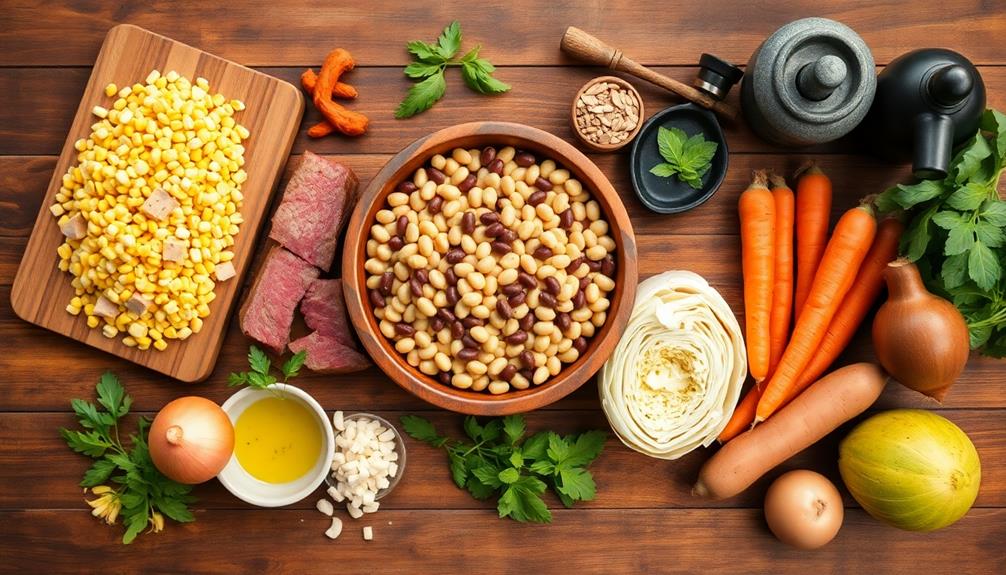
Now that your beans are ready, it's time to focus on the hominy and vegetables. First, you'll want to rinse the hominy thoroughly under cool water. Place it in a large pot and cover it with fresh water. Bring the water to a boil, then reduce the heat and let it simmer for about an hour until the hominy is tender.
While the hominy is cooking, it's time to prep your veggies. Chop up some onions, garlic, and bell peppers. The colors of the peppers will make your cachupa look vibrant and appetizing!
Don't forget to wash and cut some cabbage and carrots too. These will add a nice crunch to your dish.
Once your hominy is soft, drain it and set it aside. In a large pot, heat some oil and sauté the onions and garlic until they're golden and fragrant.
Add the peppers, cabbage, and carrots, stirring them around to coat them in the flavorful oil. Cook the vegetables until they're slightly tender but still have a bit of bite to them. Your kitchen will smell amazing!
Step 3. Cook Meats and Sausages
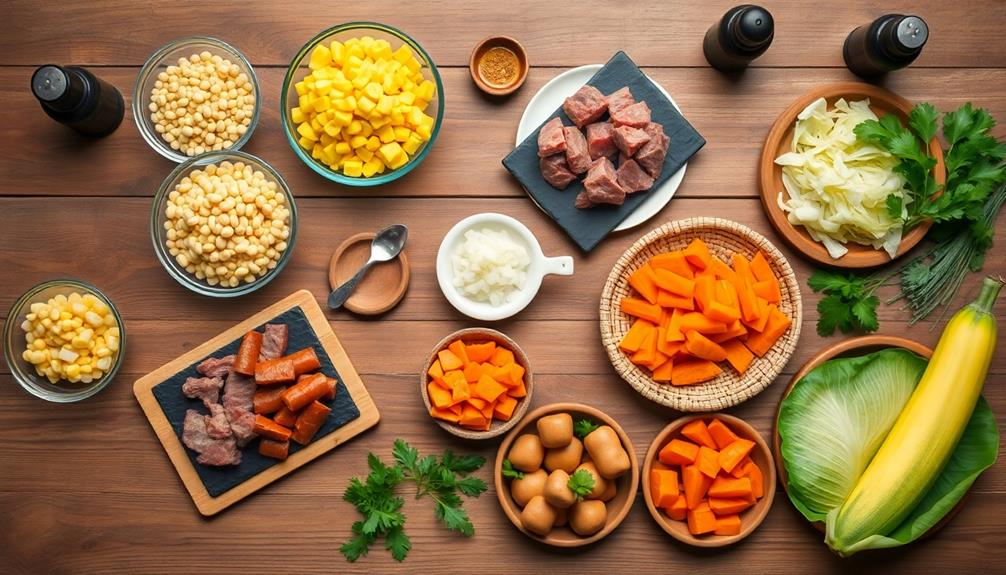
Let's tackle the meats and sausages. In a large pot, heat some oil over medium-high heat. Add your choice of meats, like diced chicken, beef, or pork, and cook them until they're nicely browned on all sides. This will give your cachupa a rich, savory flavor.
Don't forget to stir occasionally to prevent sticking!
Next, it's time for the sausages. Slice them into bite-sized pieces and add them to the pot. Cook them until they're golden and fragrant, releasing their delicious oils into the dish. The sizzling sound and mouthwatering aroma will make your kitchen smell amazing!
As the meats and sausages cook, you'll notice they start to caramelize, creating those tasty browned bits at the bottom of the pot.
These bits are flavor gold! Use a wooden spoon to scrape them up, mixing them back into the meat. This step adds depth and complexity to your cachupa.
Step 4. Simmer Ingredients Until Tender
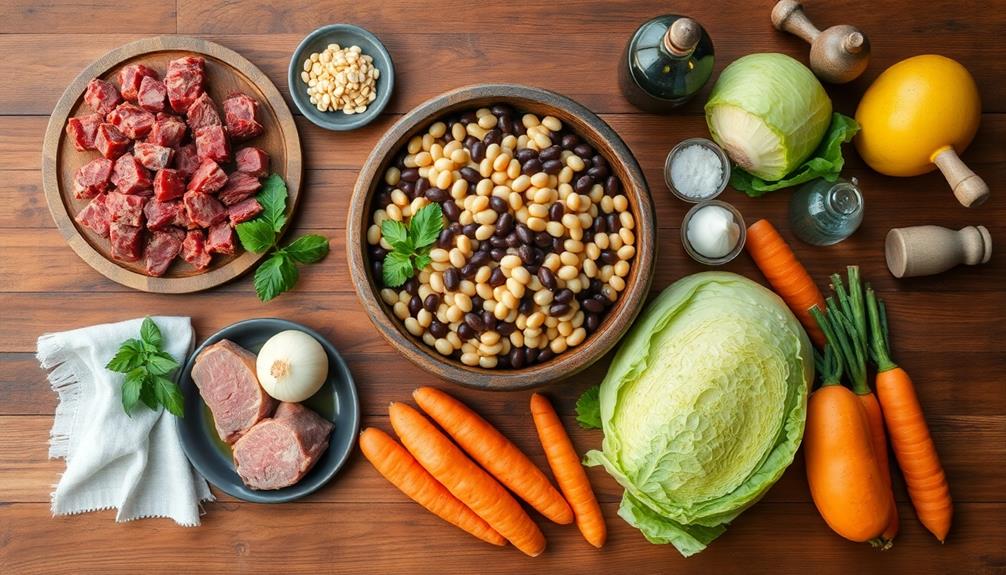
Cachupa's next essential step involves simmering the ingredients until they're perfectly tender. You'll want to keep a close eye on your pot as the magic happens! First, add enough water to cover all the ingredients, and bring it to a gentle boil.
Then, lower the heat and let everything simmer away. As the cachupa cooks, you'll notice the wonderful aromas filling your kitchen. The beans will slowly soften, and the corn will plump up nicely.
Stir the pot occasionally to make sure nothing sticks to the bottom. You might need to add more water if it starts to look too dry. This simmering process can take a while, usually about 2 to 3 hours.
But don't worry, it's worth the wait! You'll know it's ready when the beans are creamy and the corn is tender. The meats should be falling off the bone, too.
As the flavors meld together, your cachupa will transform into a rich, hearty stew that's bursting with Cape Verdean goodness. Get ready for a truly delicious meal!
Step 5. Serve With Fried Eggs

Once your cachupa is perfectly tender and flavorful, it's time to prepare the classic accompaniment: fried eggs.
Heat a non-stick pan over medium heat and add a little oil or butter. Crack your eggs into the pan, being careful not to break the yolks. Let them sizzle and cook until the whites are set but the yolks are still runny. This usually takes about 3-4 minutes.
While your eggs are frying, grab some warm plates and spoon generous portions of your steaming cachupa onto them. The rich aroma of the stew will make your mouth water!
When the eggs are done, use a spatula to carefully slide them on top of the cachupa. The bright yellow yolks will look beautiful against the colorful stew.
Now, it's time to dig in! Cut into the egg and watch as the creamy yolk runs into the cachupa, adding an extra layer of richness to the dish.
The combination of the hearty stew and the silky egg creates a perfect balance of flavors and textures. Enjoy your delicious Cape Verdean meal!
Final Thoughts
A culinary treasure, cachupa stands as a tribute to Cape Verde's rich cultural heritage and resourcefulness. This hearty stew brings together a variety of ingredients, creating a delicious meal that's both filling and comforting.
As you've learned, cachupa isn't just food; it's a symbol of the islands' history and the resilience of its people.
When you make cachupa at home, you're not just cooking a meal, you're embracing a piece of Cape Verdean culture. The aroma of simmering beans, corn, and spices will fill your kitchen, transporting you to the sunny islands.
Remember, patience is key when preparing this dish. The slow cooking process allows all the flavors to meld together perfectly.
Don't be afraid to experiment with cachupa. Try different toppings or side dishes to make it your own.
Whether you're serving it for breakfast with fried eggs or enjoying it as a hearty dinner, cachupa is sure to become a favorite in your household.
Frequently Asked Questions
Is Cachupa Suitable for Vegetarians or Vegans?
You'll find cachupa isn't typically suitable for vegetarians or vegans. It's traditionally made with meat and fish. However, you can adapt it by using only vegetables and beans, creating a plant-based version that's just as flavorful.
How Long Does Cachupa Typically Take to Prepare and Cook?
You'll need to set aside several hours to prepare and cook this dish. It's a time-consuming process, typically taking 2-3 hours. Don't rush it, as slow cooking enhances the flavors and textures of the ingredients.
What Are Some Common Side Dishes Served With Cachupa?
You'll often find cachupa served with fried eggs, linguiça sausage, or grilled fish. Don't forget to try it with avocado slices, fresh salad, or plantains. These sides complement the hearty stew perfectly, adding variety to your meal.
Can Cachupa Be Frozen and Reheated Later?
You can freeze and reheat cachupa later. It's best to store it in airtight containers and freeze for up to 3 months. When reheating, thaw it overnight in the fridge and warm it on the stovetop or microwave.
Are There Regional Variations of Cachupa Within Cape Verde?
You'll find regional variations of cachupa throughout Cape Verde. Each island has its own twist, using local ingredients and techniques. You might notice differences in meat choices, bean varieties, and cooking methods as you explore the archipelago.

